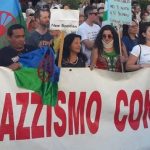NO ROOM FOR ROMA FEMINISM IN WHITE FEMINISM
If being a feminist means: being blind towards the daily violence exercised over the racialized bodies, deny the processes of dehumanization, ignore the structural racism and be accomplice with the whiteness, then I Am Not A Feminist.
When I began thinking and writing this short article I wondered about the urge for self-justification that has been chasing me not only during the entire writing process, but during all these years as an anti-racist activist and also as an academic. While we, the Roma, are facing the extreme consequences of Antigypsyism – the legitimized violence over our bodies and a brutal denial of human dignity – yet, the given historical and current denial of Antigypsyism from different institutionalized fields such as academia, anti-discrimination policies, feminist movements, media news and media production, are precisely what have created that urge for self-justification and a need to constantly proving that we, as a people, as a culture, are not responsible for the killing of our people.
I argue that this traumatic consequence cannot be understood as an isolated act of racialized violence but rather as part of the path to becoming human enough, or as Weheliye (2014) called it – when analysing gendered blackness – “the great chain of being black is vestibular to culture” (p. 43). For Weheliye, being “vestibular to culture” represents a violent passageway to the human as defined in western modernity (ibid.). I connect my own crisis with the passage/process towards humanity with the struggle to allocate political means to decolonization and oneself-existence without being the flesh/Man’s other (Weheliye, 2014, p. 134), because, as Frantz Fanon states: “all forms of exploitation are identical, since they apply to the same ‘object’: man” (in (Weheliye, 2014, p. 135). The significance of the Man as human in relation to myself, as a Romani woman or “the unbearable wrongness of being” (ibid) can be as closely read as what Hesse and Sayyid (2006) have defined as:
“The ‘white man’ was a hegemonic disposition, a dominant cadre of comportments that made possible a specific authoritarian colonial cultural style: ‘Being a White Man was, therefore, an idea and a reality”. It involved a reasoned position towards both the white and the non-white worlds” […] in addition it meant embodying the administrative cultivation of ‘race’, in which policies implementing a governing form of racism, were indispensable attributes to the colonial authority, ascribed to the disposition and the orientation of the white man” (Hesse & Sayyid, 2006, p. 18).
Following the above quotation, as well as based on Alexander G. Weheliye’s (2014) and Silvia Wynter’s (1989) understandings of the ‘Man‘ I consider that ‘Man’ entitles the modern and secular version of the human that created the Roma as non-humans. In this regard, I argue that the existence of Roma in the racialized Europe, positioned behind the mask of the permanent state of exception, has always been marked by the Man, or the colonial mechanism that reinforced a “model of radical exclusion that prevails in modern Western thinking and practice” (de Sousa Santos, 2007, p. 53).
We, as Romani women have been objects for centuries, our identities, experiences, and realities were defined by other, therefore we have never been placed as the subject. As seen in the outstanding work of bell hooks (1989) subjects are those who alone “have the right to define their own reality, establish their own identities, name their history” (p. 42). It is here we encounter clashes within white feminist movements, because while speaking about racism and sexism, how they are replicated, how they affect people, what those concepts actually mean, and so on, as seen in the reading of Ahmed, (2017) it is not enough to just “learn a new language” (p. 9), reasonably is about to recognize the limitations given by those movements by not understanding the historical perspective of racism as a matter of structuring figures and not individual manners. It is here we encounter clashes when the existing dominant positions and privileges among women are not recognized. Therefore, the notions of “sisterhood” and “universality”, are not enough. Rather, a historical consideration of the struggle for human dignity must locate its power of a universal conception of human rights in those groups exposed to European oppressiveness and colonialism. To achieve this, entails defining and debating Roma people and their struggle as a matter of political consequence and not cultural concern, hence, its debate should be political due to the fact that as Wylie (2003) has pointed it out “what counts as a “social location”, is structurally defined” (p. 31).
It is as alarming the illegal sterilization of Romani women that took place for very long time, as shocking is the absolute lack of reaction of the white feminist movement to confront such atrocities. It is under this context that I will also argue that the lack of attention given to ‘race’ within the feminist movements has not only allowed white feminists women to create and practice ‘racial patriarchy’ (SCHLOESSER, 2002), (DOYLE, 1994), but its blinded approach to address Antigypsyism made the movement to become a complicit to the racial terror over the Roma body. White feminism within the European racialized governments became the maintainers of “the savior” and “the savage” (MUTUA, 2001). This attitude became a practice within the feminist movements in their attempt to “save” Romani women from the patriarchy created by Roma men, however, I argue that those movements cannot fight against patriarchy while creating racial patriarchy (DOYLE, 1994).The constant marginalization of Romani women in feminist theories and in anti-racist policy discourse often occur because both are projected and dealt as a separate set of experience that does not precisely reflect the interaction of Antigypsyism as a form of racism and gender. Thus, producing feminism as a singular monolithic subject, without looking at racialized women’s historical and political context, it is not only unbearable to understand the oppression of those women, more importantly, it becomes impossible to offer “a solution for their liberation”.
Therefore, the construction of the white feminism cannot be understood as an anti-racist movement whereas Roma women’s perception by the majority is consequence of the so called “racialized objectification” (OPREA, 2004, p. 29). The act of silence from the white feminist movements around the racial violence over the Roma body clearly state the relationship between colonial patriarchy and the coloniality of gender (BIDASECA KARINA; VAZQUEZ LABA, 2012), thus, from one hand it depoliticizes Roma bodies, and from other it exposes Roma bodies as justifiable bodies to violence in the name of self-protection.
The original article has been published in the italian magazine @menelique. Photo credits: Giulia Ripa
https://www.menelique.com/2019/05/22/no-room-for-roma-feminism-in-white-feminism/
References:
Ahmed, S. (2017). Living a feminist life. Durham: Duke University Press.
Bidaseca Karina, & Vazquez Laba. (2012, August 18). Feminismos y poscolonialidad [Text]. Retrieved February 4, 2018, from Ediciones Godot website: http://www.edicionesgodot.com.ar/content/feminismos-y-poscolonialidad
de Sousa Santos, B. (2007). Beyond Abyssal Thinking: From Global Lines to Ecologies of Knowledges. Review (Fernand Braudel Center), 30(1), 45–89.
Doyle, L. (1994). Bordering on the Body: The Racial Matrix of Modern Fiction and Culture. Oxford University Press.
Hesse, B., & Sayyid, S. (2006). Narrating the postcolonial political and the immigrant imaginary (PhD Thesis). Columbia University Press.
Mutua, M. (2001). Savages, Victims, and Saviors: The Metaphor of Human Rights. Harvard International Law Journal, 42, 201.
Oprea, A. (2004). Re-envisioning Social Justice from the Ground Up: Including the Experiences of Romani Women. Essex Human Rights Review, 1(1), 29–39.
Schloesser, P. E. (2002). The Fair Sex: White Women and Racial Patriarchy in the Early American Republic. NYU Press.
Weheliye, A. G. (2014). Habeas Viscus: Racializing Assemblages, Biopolitics, and Black Feminist Theories of the Human. Duke University Press.
Wynter, S. (1989). Beyond the Word of Man: Glissant and the New Discourse of the Antilles. World Literature Today, 63(4), 637–648. https://doi.org/10.2307/40145557





